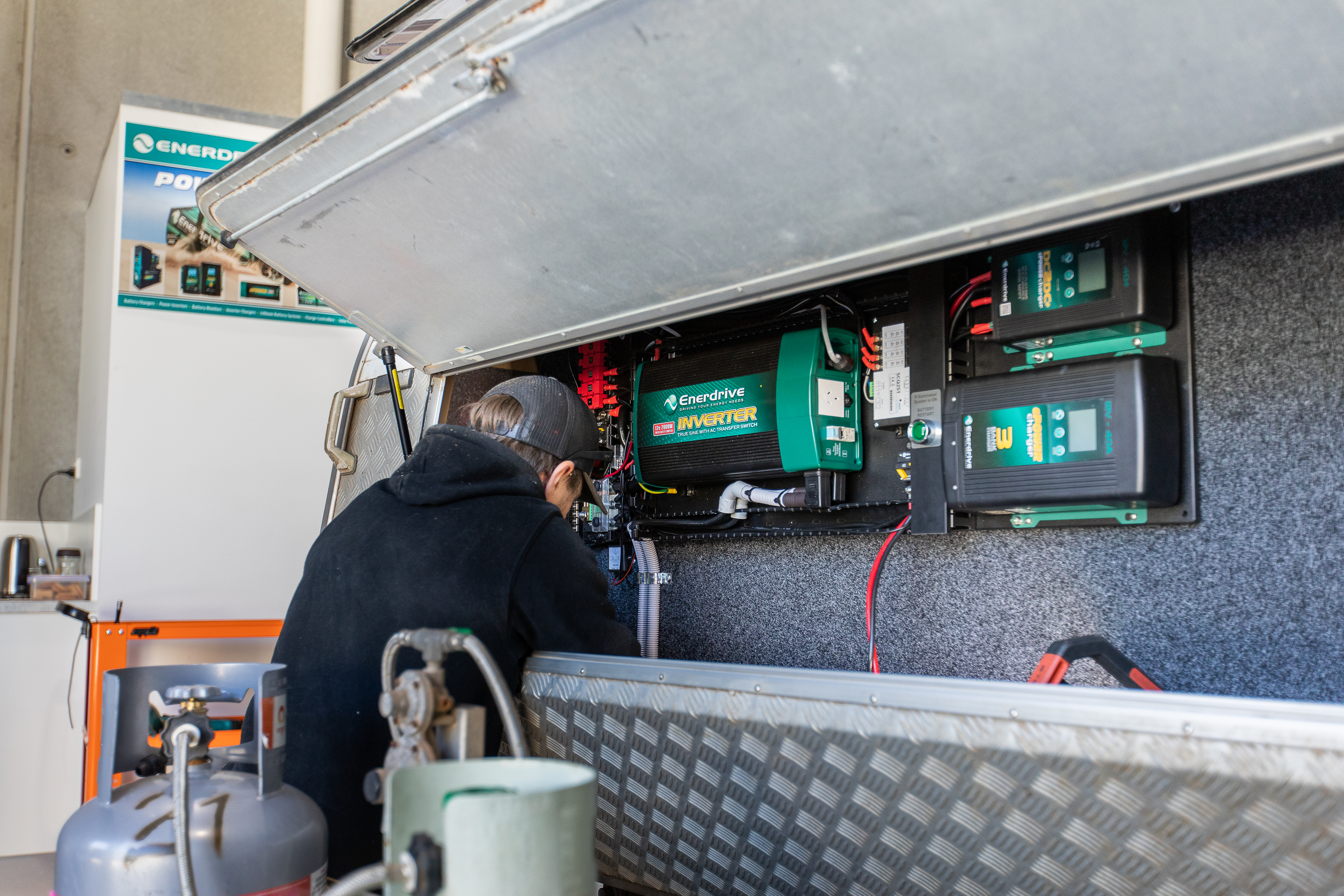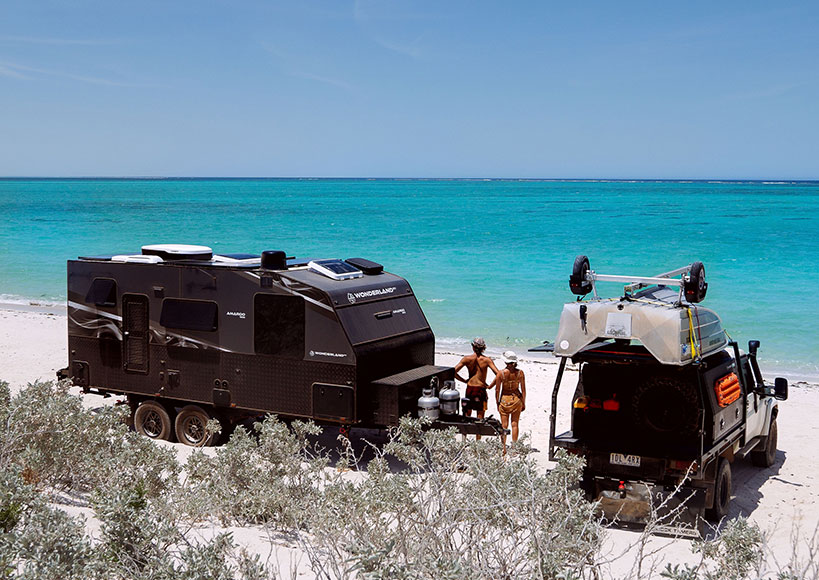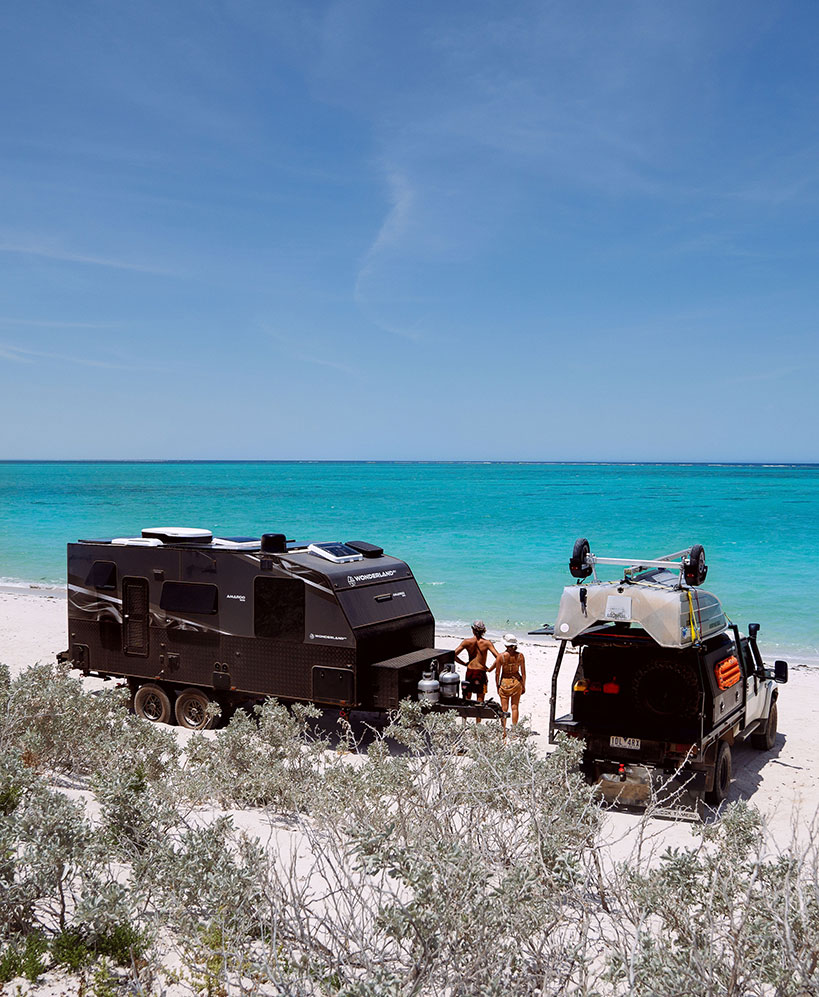As the caravan industry moved more to the use of lithium products and increased solar use, new standards were introduced towards the end of 2023. Titled AS/NZS3001.2:2022, these changes promise to revolutionise the way we approach portable connectable electrical installations, particularly in the realm of lithium battery standards. The standard is a detailed document and covers electrical installations in RVs as well as other connectable installations used for accommodation, habitation or commercial use.
This blog will highlight a few of the changes around battery standards, specifically focusing on portable connectable electrical installations in caravans, motorhomes and camper trailers.
What Is a Portable Connectable Electrical Installation?
Put simply, any vehicle that has a 240V inlet plug fitted on the outside for mains power connection. These plugs are usually 15 Amp and connect to a battery management system within the van. At time of writing, vehicles without the hard wired 240V inlet are exempt from the latest standards changes.
While these changes may seem significant, they are indeed achievable and not overly complex. Let's delve into what these upcoming regulations mean for every caravan enthusiast.
Those With Existing Power Installations
Before we get into it, it’s worth mentioning that if you already have a caravan with lithium batteries or inverters installed, and it was delivered before these new standards come into effect, there's no need to worry. The new caravan industry standards are not retrospectively enforceable. Only if you're upgrading your existing system from, say, AGM batteries to lithium, should you carefully consider the standard requirements.
If you're just starting out and want a better understanding of caravan power systems, our complete guide to off-grid setups is a great place to begin.
Standards For Installing Batteries
Perhaps the most critical aspect of the new caravan industry standards is battery fitment. Contrary to some misconceptions, you don't need to mount your batteries outside the caravan. They can be safely installed internally in non-habitable areas such as storage locations, tunnel boots, and under beds. It's essential to follow the battery manufacturer's guide for proper installation, securing, and ventilation.
If you already have a power system installed before November 18, 2023, but want to make sure your system is still complying to the new rules one simple step is segregating the lithium batteries from the rest of the system with a wall and a secured lid as well as a gasket seal to ensure the portion of the build is gas proof. This compartment can be made from any materials as long as it is sealed and secure. Another step is a single ventilation point, 20mm to the external of the caravan.
Check out our friends Dom & Jesso who did just this in their recent van build:
Solar Compliance
For parallel connections of 3 or more solar panels, compliance with the new caravan industry standard also requires individual fusing for each panel before they are connected. This additional layer of safety ensures that a short circuit in one panel won't disrupt the entire system.
Another new addition to the rules is the need for a fuse, circuit breaker, or a single point of isolation prior to the controller on the solar side. This isolation point is required regardless of the number of panels in the system and allows you to troubleshoot or test any issues you may be having with your panels or something else in the system.
Want to make sure your solar setup is safe, efficient, and compliant with the latest standards? Our detailed solar power guide for caravans breaks down everything you need to know, from panel types to system design and safety tips.
Caravan Industry Electrical Standards FAQs
-
1. Do I need to upgrade my existing caravan battery system to meet the new standards?
Not necessarily. The new AS/NZS 3001.2:2022 standards only apply to systems installed or significantly modified after November 18, 2023. If your lithium or AGM battery system was installed before this date and hasn’t been upgraded, you don’t need to make changes. However, if you're switching to lithium or installing new inverters or solar panels, you'll need to follow the latest regulations.
-
2. What is a portable connectable electrical installation?
This refers to any caravan, camper trailer, or motorhome with a 240V inlet plug (typically a 15 Amp connection) used to connect to mains power. These vehicles must meet the new electrical safety standards if the system is installed or upgraded after the enforcement date.
-
3. Why is lithium battery segregation now required?
The new rules require segregation of lithium batteries from the rest of the system to improve safety and reduce the risk of fire or gas buildup. This is done by enclosing the battery in a sealed compartment with a lid, wall, and gasket, plus a small 20mm external ventilation outlet.
-
4. Do the new solar standards affect all panel setups?
Yes. Whether you have one panel or a full solar array, the new standard requires:
- A fuse, circuit breaker, or isolator before the controller on the solar side.
- Individual fusing for 3 or more panels connected in parallel.
These updates are designed to make troubleshooting and safety management easier.
5. Can I still use AGM batteries in my caravan?
Yes, AGM batteries are still allowed. The new standards don’t ban them but do apply to all battery installations, whether AGM or lithium, if they’re installed or upgraded after the rule change. That said, many travellers are switching to lithium for its better efficiency, lighter weight, and faster charging.
6. Do I need a licensed electrician to install or upgrade my battery system?
Yes, in most cases. For any 240V wiring or major system upgrades, a licensed electrician familiar with the AS/NZS 3001.2:2022 standard is essential to ensure compliance and safety. DIY work on AC systems is not only risky but can also void warranties and insurance.
The introduction of AS/NZS 3001.2:2022 is a game-changer for the caravan industry, especially when it comes to lithium battery installations and overall electrical safety. Whether you’re building a new setup or upgrading an old one, understanding the new requirements will help ensure your caravan remains both compliant and safe. While some of the changes may seem technical, they’re ultimately designed to protect you and your rig from risk. If you’re unsure where to begin, speak with a licensed installer, your battery manufacturer, or reach out to our team — we’re always happy to help. Keeping up with the latest caravan battery and solar standards is just another step toward smarter, safer off-grid adventures.
-
DISCLAIMER* Please note, this advice is general in nature and we strongly recommend consulting the product manual and where relevant, a professional installer.
Comments (26)
12 volt sockets
Is it standard that 12 volt plugs installed in caravans in Australia starting from a basic model inclusion are wired to operate CPAP machines. Many vans now come with 12 volt sockets in bedside alcoves as an inclusion in which customers assume would operate a CPAP machine. We purchased a new van Oct 2023 and have recently experienced whilst camping off grid that the sockets would not support the operation of a 10amp CPAP machine. Your feedback on this would be greatly appreciated.By: Sonia Carruthers on 02 September 2025
www.caravanrvcamping.com.au Response
Caravans are not required to be wired to suit CPAP machines. CPAP machines are generally 240v operated and would require an inverter to operate. Generally the 12v sockets beside the beds are used to charge devices, lights and other 12v gadgets. CPAPS don't often come in 12v.
Do you need an electrical license to install the s
At what point would I need an electrical license to install the solar on My caravan.By: Gene Roulstone on 15 May 2025
www.caravanrvcamping.com.au Response
Hi Gene, a certified electrician is needed when any 240v power installation is required. It is also best practise to have an electrician look over all your power installations to ensure it meets your state or national regulations.
New battery system installation
Hi, I would like to know if there is any regulations regarding installing a new lithium battery system and 3000w inverter inside tool box on A frame at the front of the caravan next to the gas bottles which are mount externally.By: Darryl Barker on 30 March 2025
www.caravanrvcamping.com.au Response
When installing anything in a caravan near gas, it is always best practice to consult a certified gas fitter in your state. This enables you to meet the standards within your state for safe travelling. Batteries should always be installed at least 300mm from any fuel or water source/lines.
Flexible solar panel upgrade
Hi, I am looking to put 3 x 400w flexible panels on my caravan, connect them in series and feed to a victron mppt 100x50 controller. From reading your article it seems that I don't need to have any fuses, just an isolator before the controller. Is this correct?By: Robert on 22 February 2025
www.caravanrvcamping.com.au Response
Hi Robert, yes the single fusing is for parallel connections. Please also you check your Open Circuit Voltage (VOC) of the panels. Connecting in series increases voltage so checking you are within the specs of the controller is important.
Solar Fuseing
Hi I recently purchased some MC4 fuse connectors. When I inspected them they were ONLY Diodes. The retailer When I questioned the seller they said the diodes were also a fuse due to their power rateing. I have doubts re this logic! Please comment.By: Lauri Watson on 19 January 2025
www.caravanrvcamping.com.au Response
HI Lauri, MC4 Diodes prevent reverse current flow, while fuses protect against overcurrent. They can't be used interchangeably as they serve different purposes.
Solar Fusing
If placing 10 panels upon the roof of a caravan, are we running 10 cables down, fused at the panel and then to a fuse box then an isolator, similar to the video above? Or can we use the MC4 fuse solar connectors, then cables into a string and down to the isolator so only 2 cables coming through the roof? Which is the compliant way? We are reading it as the second version of my comment.By: Indy on 13 November 2024
www.caravanrvcamping.com.au Response
Hi Indy, there needs to be individual fusing per panel, prior to the panels being connected in parallel
lithium batteries situated under a vanity and besi
If lithium batteries, inverter,controller,battery monitor are all in a cupboard under a vanity beside a sink in a new van ,will they comply with the new regulations. The vanity is at the rear of the van.By: john kennedy on 27 October 2024
www.caravanrvcamping.com.au Response
Hi John, if this is a brand new caravan with lithium installed then they should have made this compliant. It is easy to tell, all you need to do is check the lithium batteries are in their own sealed box with ventilation to the outside of the caravan.
Solar
Why do you need the breaker switch before the reg if each panel is fused ie 4 panels 4 fusesBy: Rod on 09 October 2024
www.caravanrvcamping.com.au Response
Hi Rod, great question. It provides a point of isolation, allowing you to safely work on the system if needed. It is also a great way to troubleshoot when on the road. You can isolate the whole solar array to test other components in your system. If it is your solar you can then test each panel individually.
Additional lithium battery capacity
I have a pre Nov 2023 model caravan with a single lithium battery , battery management system etc inside the van under one of the beds. I want to add additional battery(ies) in parallel just to increase my battery capacity for off grid camping. Does this mean I need to comply with the new standard .. it’s not an upgrade from AGM to lithium but an upgrade to an existing Lithium setup! Thanks GregBy: Greg Spencer on 02 September 2024
www.caravanrvcamping.com.au Response
Hi Greg, if you are adding a new battery as a standalone or addition to an existing system and you want the caravan to be compliant with the new regulations then, yes it is best practice to make these changes.
Solar
In your initial comment you state 3 or more panels in parallel need to be individually fused but then in one of your replies you state for 4 or more in parallel? Is it 3 or more or 4 or more?By: Craig on 15 August 2024
www.caravanrvcamping.com.au Response
Hi Craig, sorry for the confusion. I can confirm it is 3 or more panels
Replacing solar panels
Hi If I am replacing solar panels on my van manufactured 2012 do I need to meet new requirementsBy: Bruce on 15 July 2024
www.caravanrvcamping.com.au Response
Hi Bruce, it is always best practise to follow any new guidelines
Lithium batteries in caravan boot
Can fit lithium batteries in my boot in a sealed box with my gas bottles on the draw barBy: Stephen reid on 13 July 2024
www.caravanrvcamping.com.au Response
Hi Stephen, it is always best to contact your local gas professional in your state to check the distances lithium batteries can installed from gas bottles
Solar panel fusing
How mate I am planning to have 2 solar panels in series on my roof. Do I need to fuse each panel individually, therefore wire each panel into the van to fuse and connect in series. Or can I connect the panels on the roof and fuse the string in the van then through an Isolator.By: Kyle on 17 June 2024
www.caravanrvcamping.com.au Response
Hi Kyle, you only need to fuse each panel if there is 3 or more panels connected in parallel. With your set up you will need to fuse between your panels and the solar controller and from the solar controller to the battery.
Parallel or Series
Just reading your article and are you sure it’s right. It says “ Solar Compliance: For parallel connections of 3 or more solar panels, compliance with the new caravan industry standard also requires individual fusing for each panel before they are connected. ” I just read the standard and it says series. Multiple panels in series are a string. Not parallel.By: Scott on 05 June 2024
www.caravanrvcamping.com.au Response
Hi Scott, thanks reaching out. I am not sure which standard you are reading. The AS/NZS 3001.2:2022 Electrical Installations Standard states that there is a requirement for individual fusing and isolation points prior to the panels being connected in parallel. This is to prevent one faulty panel taking out an entire string of panels. A string of panels can be either parallel or series.
'Smart' Lithium batteries to replace existing AGM
My 6yo caravan is fitted with a 100Ah AGM battery and solar panel and 240V charger to suit. I'll likely need to replace the battery quite soon. I note that there are now a number of vendors offering 'Smart' lithium batteries which appear to be a standard lithium battery with some interface circuitry and posts/connections and are offered as a suitable replacement for an AGM battery. These batteries seem to offer the best of both worlds - less weight and greater capacity while eliminating the need to replace solar controllers and 240V chargers. I imagine that the installation of such a lithium battery will need to be segregated as per your original article and the new rules. Do you have any comments or concerns with this middle-way approach?By: Ron Hoskin on 09 April 2024
www.caravanrvcamping.com.au Response
Hi Ron, upgrading to lithium is a very easy thing to do with just a couple of slight changes to the installation. I have sent you an email on this for you to have a look at. Please feel free to reach out to us on 1800 787 278 if you have any further questions.
'Smart' Lithium batteries to replace existing AGM
My 6yo caravan is fitted with a 100Ah AGM battery and solar panel and 240V charger to suit. I'll likely need to replace the battery quite soon. I note that there are now a number of vendors offering 'Smart' lithium batteries which appear to be a standard lithium battery with some interface circuitry and posts/connections and are offered as a suitable replacement for an AGM battery. These batteries seem to offer the best of both worlds - less weight and greater capacity while eliminating the need to replace solar controllers and 240V chargers. I imagine that the installation of such a lithium battery will need to be segregated as per your original article and the new rules. Do you have any comments or concerns with this middle-way approach?By: Ron Hoskin on 05 April 2024
www.caravanrvcamping.com.au Response
Hi Ron, first and foremost I would check the compatibility of your existing chargers to ensure they are suitable for lithium profiles. Some lithium batteries do offer a bluetooth function for wireless monitoring. Swapping out lithium is quite easy so please feel free to contact us on 1800 787 278 to discuss the range we have available. You can also jump on our live chat directly on our website during business hours
Lithium Battery Ventilation
I note that there needs to be a single ventilation point for lithium batteries. It states there has to be a single ventilation point for the batteries 20mm to the external wall of the caravan. Does this point have to be at least a 20mm hole? Hoping you can clarify this issue for me.By: Ron Jardine on 29 January 2024
www.caravanrvcamping.com.au Response
Hi Ron, the ventilation hole needs to be a minimum of 20mm
Lithium and Agm batteries
Hi I have a Mazda t3500 bus with batteries mounted underneath, can I have a lithium battery and a Agm battery stored side by side?. Also regarding the new solar laws I have 2 panels to my lithium battery BMS and one panel to my starter BMS both with circuit breakers so I can switch from charging with solar or alternator. Do I still need to put a fuse between each panel? Thanks for your time.By: Boyd Thompson on 20 January 2024
www.caravanrvcamping.com.au Response
Hi Boyd, first and foremost lithium batteries need to be stored in a dry and cool location. If this isn't possible underneath your bus then you will have to come up with an alternative location. Simply storing a lithium battery and an AGM battery side-by-side without any electrical connection does not pose an inherent safety risk. However, there are still some potential downsides to consider: Temperature extremes: While both lithium and AGM batteries can handle a wide range of temperatures, their optimal storage temperatures differ. Ensure both batteries are stored within their recommended temperature range to avoid compromising their lifespan. Accidental contact: Although unlikely, accidental contact between terminals or exposed wires could lead to a short circuit, especially if the batteries are stored in a confined space. Take precautions to prevent any possibility of contact. Acid leaks: AGM batteries, though sealed, can still leak electrolyte if damaged. Spilled electrolyte can damage the lithium battery casing and pose environmental hazards. Store both batteries on sturdy, non-conductive surfaces and ensure leak-proof containment for the AGM battery. Overall, while simply storing the batteries separately is not unsafe, following best practices for battery storage and handling will further minimize any potential risks and ensure optimal performance for both types of batteries. Regarding the solar panels the requirements for the new standard ask for Individual fusing per panel prior to those panels being joined in parallel. So you would need to have a fuse between the 2 panels to your lithium battery if they are connected in parallel. This information serves as guidance, and the suggestions made do not assure compliance with your system. It is advisable to thoroughly review and comprehend AS/NZS 3001.2:2022 to ensure the adherence of your system to the specified standards.
Solar and lithium systems
Thank you for a very informative description of the the above . Glad these standards have been brought in. Let's hope caravan owners can go to a professional installer with peace of mind.By: John laoumtzis on 18 January 2024
Lithium conversion
This seems to be another regulation brought about by alarmist publications who continue to promote and profit from the use of AGM batteries. They have worked their way in to the regulators pockets and now we have it legislated. The massive growth in caravanning since covid will obviously be a lovely money spinner!!
www.caravanrvcamping.com.au Response
Hi Wayne, regulations such as these are introduced to keep people safe. We support the use of AGM and Lithium depending upon peoples individual needs, applications and budget. If you are after a battery of any chemistry, feel free to reach out to us on 1800 787 278 we would be more than happy to assist
Lithium
I have all AGM in everything my friend was a fire chief was advised not to use because you can't extinguish a lithium battery fireBy: J Critchley on 16 January 2024
www.caravanrvcamping.com.au Response
I understand your hesitancy in swapping over to lithium. However if you heed to the guidelines with installation and use, lithium is a great alternative to keep towing weight down whilst giving your more power on the road.
Upgrade
Hi I have a essential van mid 23 model , I have a agm battery in a outside location with a Impro control system I want to upgrade to Lithium battery is that ok to mount outside and is the Impro system ok with new rules .By: Mal Kent on 16 January 2024
www.caravanrvcamping.com.au Response
Hi Mal, changing over to lithium is exciting and you will certainly notice the difference in how long you can be off grid for over AGM. We need to know more information on the charging system you have so we will reach out directly to you via email. Alternatively you can give us a call on 1800 787 278 or jump on our live chat on our website to speak to us
Lithium batteries
Can you put lithium batteries in where existing batteries already are, they are in a box underneath the caravanBy: Brian on 16 January 2024
www.caravanrvcamping.com.au Response
Hi Brian, storing lithium batteries outside the van will be fine as it is not classed as a habitable environment. You will need to keep in mind they need to be stored away from water, direct sunlight and heat sources.
Lithium battery box Btec 200
Can Enerdrive supply a Gas proof battery box for the Btec 200 amp lithium battery in kit form with vent tube and outlet that will satisfy the new electrical requirements without making cabinet alterations?By: Dean Gungl on 16 January 2024
www.caravanrvcamping.com.au Response
Hi Dean, there is nothing on the market at the moment to adhere to these changes.
cooling
If the battery compartment is completely sealed, what do you do about cooling of the batteries ?. If a fan and vent is installed that negates the compartment sealing.By: Graham Porter on 16 January 2024
www.caravanrvcamping.com.au Response
Hi Graham, thanks for bringing this point up. First and foremost it is always important to refer back to the manufacturer of your battery for their fitment guide. Most if not all lithium batteries will require ventilation. Generally speaking a 20mm vent to the outside of the caravan should suffice, however we can't stress enough how important it is to speak to your manufacturer to ensure you comply
Leave a comment
Trending Topics









